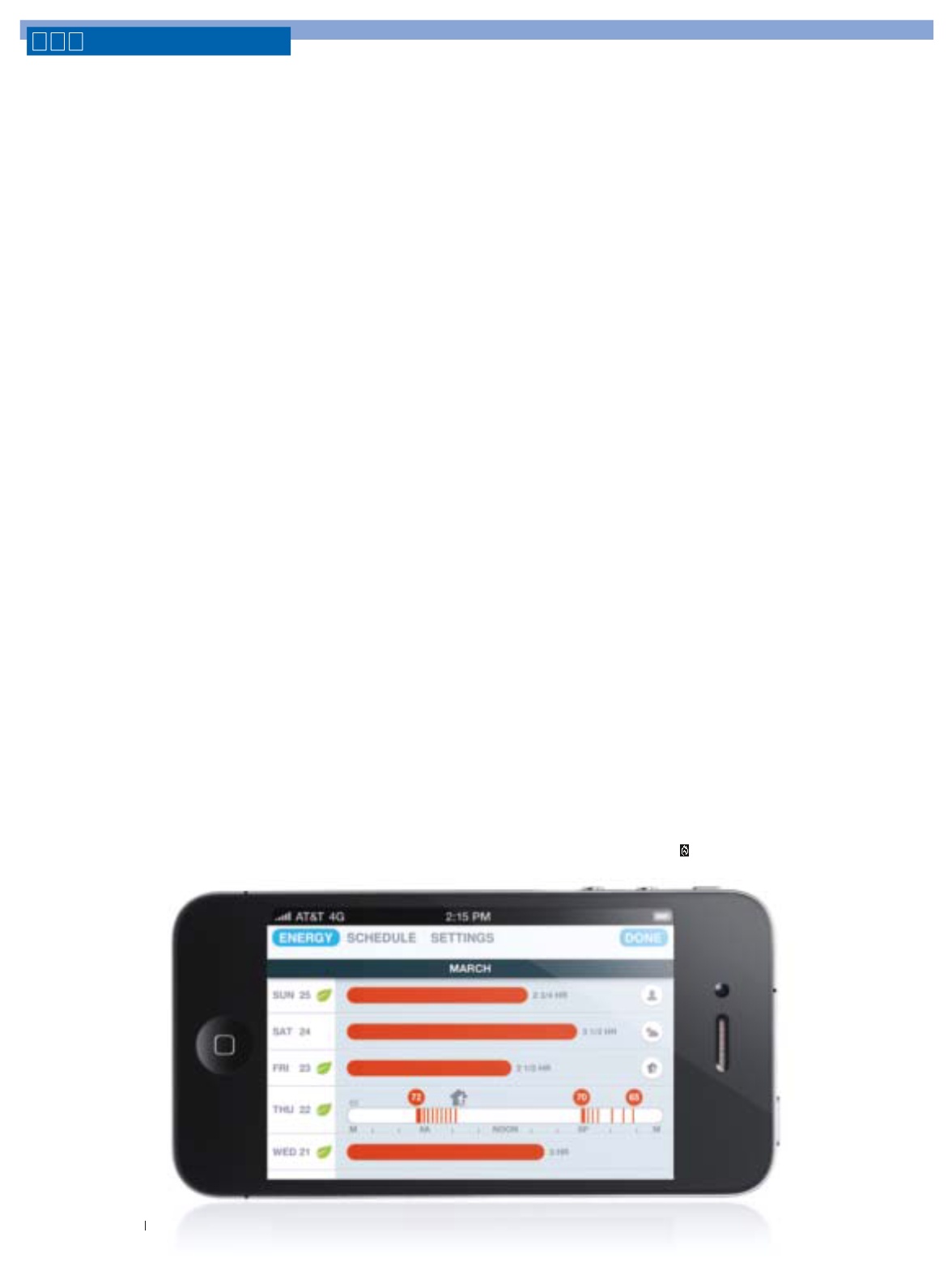
HVAC Controls
stat in the field. Last year, Nest rolled out
Airwave
™
, which uses an algorithm to lower
air conditioning costs by turning off the
compressor before the fan, allowing the fan
to move the latent cold air into the home.
MAKING EFFICIENCY FUN
While the self-programming is the main
attraction, Nest is going much farther to
connect customers with their home energy
usage. The thermostat uses a system of user
feedback that centers on the “Nest Leaf” to
encourage energy conservation.
Whenever a homeowner sets the ther-
mostat to a more energy efficient setting
than they normally use and leaves it for at
least an hour, they can earn one Nest Leaf.
Although it has no intrinsic value, the Leaf
is a type of reward that lets the user know
they are saving energy. “People love getting
Leafs,” Brinks said.
The feedback system can be expanded
with the use of a Nest Energy Report, a
monthly e-mail report that Nest sends to
customers whose thermostats are con-
nected to Wi-Fi and associated with a Nest
account. The report shows how many hours
of heating and cooling the home used; a
summary of how many Nest Leafs were
earned; and how many times the thermostat
switched to Auto-Away mode. The Energy
Report also has a “Kudos” section, where
a user can learn how their energy usage
compares to other “Nesters.”
A house with multiple zones can have
multiple Nest thermostats that communi-
cate with each other. The zones all switch
to Auto-Away when no motion is detected
in the home. Once one thermostat senses
motion, all thermostats in the home switch
back to active mode. In a zoned system, the
homeowner adjusts each Nest thermostat at
first to “teach” it a program for that zone.
“The Nest has an Auto-Away mode that
it shifts into when it senses that you’ve left
the house. If you override that setting, it can
wait longer next time,” Brinks said. “It also
learns about your home, such as how long
it takes to heat and cool, and other factors.
It knows what systems are radiant or forced
air and treats those differently.”
REMOTE ACCESS
While the learning features are unique
to Nest, the thermostat also offers remote
access through the Internet, similar to other
contemporary thermostats. The user can
adjust one or more Nest thermostats by log-
ging into their account on an iPhone, iPod
touch, iPad or Android smartphone and
using the Nest Mobile app. Users can adjust
temperatures, change program schedules
and view their energy history.
With the release of its 2nd generation
thermostat in October 2012, Nest uses its
System Match software to identify the types
of heating systems in the home, including
forced hot air, radiant and heat pump. The
thermostat might ask the homeowner to
confirm the equipment that it senses.
“System Match changes Nest’s algorithms
and activates different features depending
on what kind of system you have,” Nest
explains on its website. “These features,
including Early-On, Heat Pump Balance,
True Radiant and Filter Reminders, are
designed to make your heating or cooling
system work better so you can save energy
and stay more comfortable.”
CONTRACTOR CERTIFICATION
Sales of Nest Learning Thermostats occur
largely in consumer channels, but Nest also
k ith HVAC f i
l C t t
wor s w
pro ess ona s. on rac ors
can become certified Nest installers by
signing on with the company. Nest provides
selling tips and marketing materials, and
online training is available through the
Nest Certified portal (nest.com/certified).
The company has an installer search on its
website that homeowners can use to find a
certified Nest installer. The company already
has 10,000 certified installers.
“Our goal is to have customers ask their
local heating and cooling guy, ‘What do you
think about Nest? And how else can I save
energy?’ We hope to push that conversation
to the forefront,” Brinks said.
Nest also works closely with some utili-
ties. For example, National Grid customers
in Massachusetts and Rhode Island can
now get $100 off a $249 Nest Learning
Thermostat when purchasing through
the utility. Available only to gas heat cus-
tomers, the discount is immediate, with no
paperwork to complete.
Nest is also working with select utilities
on demand response programs that can auto-
mate the dialing-back of power usage during
periods of peak electric use. Nest’s Rush
Hour Rewards program, which it runs with
Southern California Edison, Green Mountain
Energy and other electric utilities, earns cus-
tomers rebates by automating their demand
response with temperatures setbacks.
Nest’s Seasonal Savings program, which
is also available only through partnering
energy companies, promotes energy saving
by tweaking thermostat settings twice a year
for greater savings. “Seasonal Savings will
automatically tweak some temperatures in
your schedule to make them more efficient,
while still keeping you comfortable. You
can change the temperature or adjust your
schedule at any time, but if you stick with
Seasonal Savings’ tuned-up schedule, our
studies show that Nest owners use 5-10%
on its
less heating or cooling,” Nest reports
website.
16 • OIL
&
ENERGY


